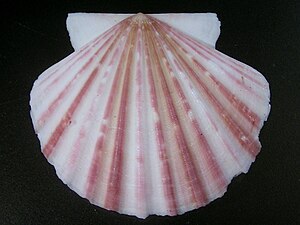หอยเชลล์
| หอยเชลล์ หอยพัด ช่วงเวลาที่มีชีวิตอยู่: ไทรแอสซิกตอนกลางถึงปัจจุบัน | |
|---|---|

| |
| การจำแนกชั้นทางวิทยาศาสตร์ | |
| อาณาจักร: | Animalia |
| ไฟลัม: | Mollusca |
| ชั้น: | Bivalvia |
| ชั้นย่อย: | Pteriomorphia |
| อันดับ: | Pectinoida |
| อันดับย่อย: | Pectinina |
| วงศ์ใหญ่: | Pectinoidea |
| วงศ์: | Pectinidae Wilkes, 1810 |
| สกุล[1] | |
|
| |
หอยเชลล์ หรือ หอยพัด (อังกฤษ: scallop) เป็นสัตว์มอลลัสกาฝาคู่อาศัยอยู่ในทะเล จัดอยู่ในวงศ์ Pectinidae หอยเชลล์พบได้ทุกมหาสมุทรของโลก หอยเชลล์จำนวนมากเป็นแหล่งอาหารราคาสูง ทั้งเปลือกสีสว่าง รูปพัดของหอยเชลล์บางตัว พร้อมกับแบบร่องเว้าแผ่ออกจากศูนย์กลาง ทำให้มีค่าสำหรับนักสะสมหอย
โดยชื่อสามัญในภาษาอังกฤษคำว่า "scallop" แผลงมาจากภาษาฝรั่งเศสเก่า escalope หมายถึง "เปลือก"
กายวิภาค
[แก้]เช่นเดียวกับหอยนางรมแท้ (วงศ์ Ostreidae) หอยเชลล์มีกล้ามเนื้อปิดฝาอยู่ตรงกลาง ดังนั้นข้างในเปลือกของหอยมีแผลเป็นกลางอันเป็นลักษณะเฉพาะ เป็นจุดยึดสำหรับกล้ามเนื้อนี้[2] กล้ามเนื้อปิดฝาของหอยเชลล์ใหญ่กว่าและพัฒนากว่ากล้ามเนื้อปิดฝาของหอยนางรม เพราะพวกมันเป็นนักว่ายน้ำที่กระตือรือร้น ชาวประมงและนักวิทยาศาสตร์บางคนบอกว่า หอยเชลล์เป็นสัตว์อพยพ แต่มีหลักฐานสนับสนุนน้อยอยู่[3] เปลือกของมันค่อนข้างมีลักษณะสม่ำเสมอ ซึ่งทำให้นึกถึงหอยทะเลต้นแบบ และเพราะรูปทรงเรขาคณิตที่น่าพอใจนี้เอง ทำให้เปลือกหอยเชลล์เป็นของประดับตกแต่งทั่วไป
หอยเชลล์มีตาธรรมดามากถึง 100 ดวง (จากการศึกษาล่าสุดพบว่ามีมากถึง 200 ดวง[4]) ร้อยอยู่รอบขอบแมนเทิลของมันเหมือนกับร้อยลูกปัด ดวงตาเหล่านี้มีจำนวนไม่คงที่ เพราะธรรมดาสำหรับหอยประเภทนี้ที่จะงอกตาใหม่เพิ่ม ทั้งยังงอกใหม่เวลาบาดเจ็บได้ด้วย[5] หากมันสูญเสียดวงตาทั้งหมด มันจะกลับมาเหมือนเดิมภายในสองเดือน[5] ดวงตาเหล่านี้เป็นดวงตาสะท้อนแสง ขนาดเส้นผ่านศูนย์กลางราวหนึ่งมิลลิเมตร มีโครงสร้างของผลึกใสหรือคริสตัล รูปทรงสี่เหลี่ยมทำหน้าที่สะท้อนแสงเข้าสู่เรตินา[4] โดยมีเรตินาซึ่งมีความซับซ้อนกว่าเรตินาของหอยฝาคู่แบบอื่น ตาของมันประกอบด้วยเรตินาสองประเภท ประเภทหนึ่งตอบสนองต่อแสง และอีกประเภทหนึ่งขับความมืดออกไป อย่างเช่น เงาของผู้ล่าที่อยู่ใกล้ ๆ ดวงตาเหล่านี้ไม่สามารถแยกแยะรูปทรงได้ แต่รับรู้การเปลี่ยนแปลงลักษณะของแสงและการเคลื่อนไหวได้[6][7]
ดวงตาสะท้อนแสงนี้แทนเลนส์ที่ข้างในตาเรียงรายไปด้วยกระจกซึ่งสะท้อนภาพไปโฟกัสที่จุดกึ่งกลาง[8] ธรรมชาติของดวงตาเหล่านี้หมายความว่า หากดวงหนึ่งจ้องเข้าไปในรูม่านตาของดวงตา ดวงตานั้นจะเห็นภาพเดียวกับที่สิ่งมีชีวิตนั้นเห็น โดยสะท้อนกลับออกมา[8] หอยเชลล์สกุล Pecten มีดวงตาสะท้อนแสงขนาดถึง 100 มิลลิเมตร อยู่ตรงขอบเปลือก ซึ่งสามารถตรวจจับวัตถุเคลื่อนไหวขณะที่เคลื่อนผ่านเลนส์ต่อเนื่องกัน[8]
สกุล
[แก้]- Aequipecten Fischer, 1886
- Amusium Roding, 1798
- Argopecten Monterosato, 1889
- Bractechlamys Iredale, 1939
- Caribachlamys Waller, 1993
- Chlamys Röding, 1798
- Crassadoma Bernard, 1986
- Cryptopecten Dall, Bartsch & Rehder, 1938
- Decatopecten Sowerby II, 1839
- Delectopecten Stewart, 1930
- Euvola Dall, 1898
- Haumea Dall, Bartsch & Rehder, 1938
- Hinnites De France, 1821
- Hyalopecten Verrill, 1897
- Laevichlamys Waller, 1993
- Leptopecten Verrill, 1897
- Lindapecten Petuch, 1995
- Lyropecten Conrad, 1862
- Malanochlamys
- Nodipecten Dall, 1898
- Palliolum di Monterosato, 1884
- Patinopecten Dall, 1898
- Pecten Muller, 1776
- Placopecten Verrill, 1897
- Spathochlamys Waller, 1993
อ้างอิง
[แก้]- ↑ "Pectinidae". ระบบข้อมูลการจำแนกพันธุ์แบบบูรณาการ. สืบค้นเมื่อ 2017-12-12.
- ↑ National Museum Wales, Department of Biodiversity & Systematic Biology. "Bivalve Shell Structures". สืบค้นเมื่อ 2011-08-15.
- ↑ Scallops: Biology, Ecology and Aquaculture, Volume 35, Second Edition (Developments in Aquaculture and Fisheries Science). Elsevier Science. 2006. p. 709. ISBN 978-0444504821. สืบค้นเมื่อ 2011-08-15.
- ↑ 4.0 4.1 หน้า 7 วิทยาการ-เกษตร, หอยเชลล์มีดวงตาที่น่าทึ่งถึง 200 ตา. "ทันโลก". ไทยรัฐปีที่ 68 ฉบับที่ 21875: วันอังคารที่ 12 ธันวาคม พ.ศ. 2560 แรม 9 ค่ำ เดือน 1 ปีระกา
- ↑ 5.0 5.1 Burton, Maurice (2002). International Wildlife Encyclopedia. Marshall Cavendish Corporation. pp. 2248–2249. ISBN 978-0761472827. สืบค้นเมื่อ 2011-08-15.
((cite book)): ไม่รู้จักพารามิเตอร์|coauthors=ถูกละเว้น แนะนำ (|author=) (help) - ↑ http://www.asknature.org/strategy/1e779a45a88aef5c45448073f1e77216
- ↑ Land MF and Fernald RD (1992) "The evolution of eyes" เก็บถาวร 2018-01-09 ที่ เวย์แบ็กแมชชีน Annual review of neuroscience, 15: 1–29.
- ↑ 8.0 8.1 8.2 Land, M F; Fernald, R D (1992). "The Evolution of Eyes". Annual Review of Neuroscience. 15: 1–29. doi:10.1146/annurev.ne.15.030192.000245. PMID 1575438.
แหล่งข้อมูลอื่น
[แก้]Text is available under the CC BY-SA 4.0 license; additional terms may apply.
Images, videos and audio are available under their respective licenses.
